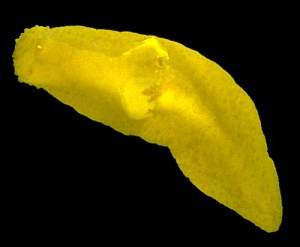
Notodoris citrina
Bergh, 1875
Order: NUDIBRANCHIA
Suborder: DORIDINA
Superfamily: ANADORIDOIDEA
Family: Aegiretidae
DISTRIBUTION
Tropical Indo-West Pacific.
PHOTO
off Anse Vata, between Île aux Canards & Rocher a la Voile, Nouméa, New Caledonia, 12-13m, 15 October 1988. 35mm long alive. PHOTO: Bill Rudman.
Notodoris citrina is a common western Pacific species. Adult animals are uniformly yellow and can be distinguished from other species of the genus by their lack of black pigmentation, although, as discuused in messages below, juveniles appear to have black rhinophores. It can also be distinguished by the position of its gills, which are about one-third of the way down the body from the anterior end. In other species of Notodoris, the gills are approximately midway down the body. The body is rigid and leathery to touch, the thickened skin being toughened with tiny spicules. Small irregular pustules cover the upper surface of the body. The rhinophores are smooth, simple. And realtively small. Notodoris citrina grows to approximately 60mm in length. It is generally found on coral reefs from the low intertidal to about 40m in depth. It is commonly reported to feed on yellow calcareous sponges of the genus Leucetta.
References:
• Bergh, L.S.R. (1875). Neue Nacktschnecken der Südsee. 3. Journal de Museum Godeffroy, 3(8): 53-100 (185-232).
• Marshall, J.G. & Willan, R.C. (1999). Nudibranchs of Heron Island, Great Barrier Reef. A survey of the Opisthobranchia (Sea Slugs) of Heron and Wistari Reefs. Backhuys Publishers, Leiden, The Netherlands, 257 pp.
• Wells, F.E. & Bryce, C.W. (1993). Sea slugs and their relatives of Western Australia. Western Australian Musum, Perth. 184 pp.
Rudman, W.B., 2003 (July 11) Notodoris citrina Bergh, 1875. [In] Sea Slug Forum. Australian Museum, Sydney. Available from http://www.seaslugforum.net/find/notocitr
Related messages
Notodoris citrina from sthn Queensland
October 1, 2009
From: Gary Cobb
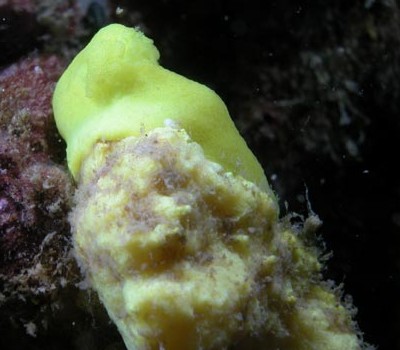
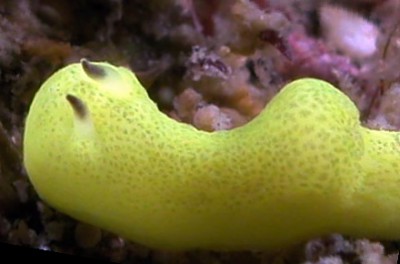
Concerning message #13117:
Hi Bill and everyone!
Here is a record for Notodoris citrina in this area. This species has been recorded here at 70 mm in length. Juveniles do have black tipped rhinophores. I have included a photo of an adult on it food source.
Locality: Mooloolaba, Sunshine Coast, 17 m, Queensland, Australia, Pacific Ocean, 15 June 2009, Subtidal. Length: 70 mm. Photographer: Gary Cobb and David Mullins.
Cheers
Gary Cobb
gary@nudibranch.com.au
Cobb, G.C., 2009 (Oct 1) Notodoris citrina from sthn Queensland. [Message in] Sea Slug Forum. Australian Museum, Sydney. Available from http://www.seaslugforum.net/find/22553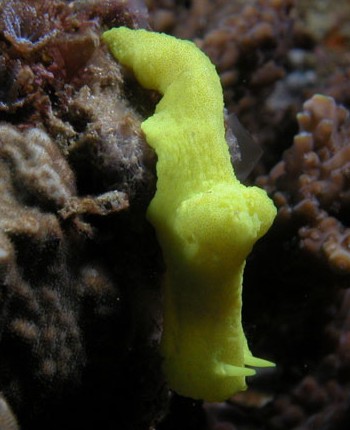
Thanks Gary,
Best wishes,
Bill Rudman
Notodoris citrina from Indonesia
February 17, 2005
From: Mike Oelrich
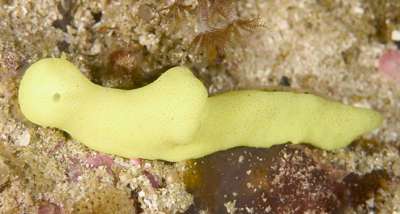
Hi Bill,
I traveled to Indonesia (Raja Empat islands) in November 2004 and can't identify this think yellow one which was about 2"-2.5" long and was found at about 50 fsw.
Mike Oelrich
moelrich@cox.net
Oelrich, F.M., 2005 (Feb 17) Notodoris citrina from Indonesia. [Message in] Sea Slug Forum. Australian Museum, Sydney. Available from http://www.seaslugforum.net/find/13117Dear Mike,
This is Notodoris citrina.
Best wishes,
Bill Rudman
Notodoris citrina from Lord Howe Island
January 28, 2003
From: W.B. Rudman
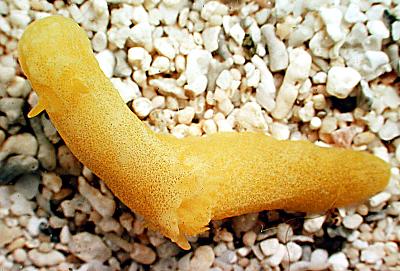
Here is a photo record from Ian Hutton of Notodoris citrina from Lord Howe Island.
Location: Blunts Hole.
Bill Rudman
Rudman, W.B., 2003 (Jan 28) Notodoris citrina from Lord Howe Island. [Message in] Sea Slug Forum. Australian Museum, Sydney. Available from http://www.seaslugforum.net/find/8975Ontogenetic colour change in Notodoris
November 29, 2002
From: Richard Willan
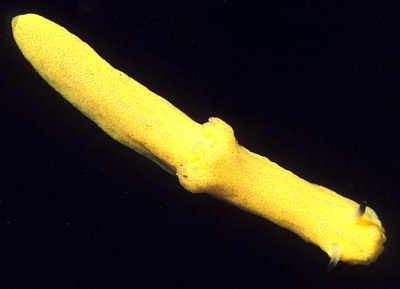
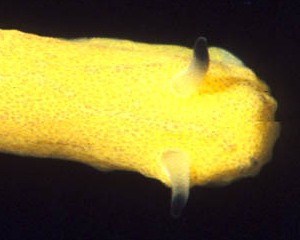
Dear Bill,
I think your hypothesis that the coloration of the rhinophores of Notodoris gardineri changes from black to yellow as an animal grows up from a juvenile to an adult is correct. I have photographs of four different juvenile animals between 10 to 14mm long alive [including the one identified as Notodoris sp. 1 in Marshall & Willan (1999)], all with black rhinophores, and I have never seen a juvenile this size with yellow rhinophores. One juvenile animal of 26mm had pale grey rhinophores indicating the colour change was occurring at that size.
Actually this phenomenon may occur in all the three yellow species of Notodoris.
I attach an image of a juvenile (22mm long alive) Notodoris citrina. Notice that it too has black rhinophores.
Photo location: 15 metres depth, Outer Gneering Shoals, off Mooloolaba, southern
Queensland, R.C. Willan, 7 July 1990.
Regards,
Richard Willan
Richard.Willan@nt.gov.au
Willan, R., 2002 (Nov 29) Ontogenetic colour change in Notodoris. [Message in] Sea Slug Forum. Australian Museum, Sydney. Available from http://www.seaslugforum.net/find/8531Thanks Richard,
I had been wondering whether anyone knew anything about juvenile N. citrina. It certainly seems the 3 yellow species start life with black rhinophores.
Best wishes,
Bill Rudman
Notodoris citrina from Queensland
August 7, 2001
From: Carle Parkhill
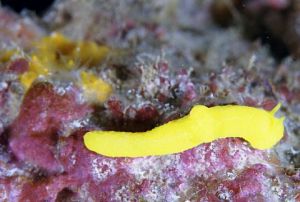
Dear Bill,
I've been doing a lot of underwater photography and never had trouble until this shot. The camera wouldn't focus on the subject, it was like looking at a fluorescent light. Could you please tell me what sort of nudibranch it is? It is from off Mooloolaba, Queensland, Australia, in about 15 meters.
Thanks
Carle
carlesam@australis.aunz.com
Parkhill, C., 2001 (Aug 7) Notodoris citrina from Queensland. [Message in] Sea Slug Forum. Australian Museum, Sydney. Available from http://www.seaslugforum.net/find/4911Dear Carle,
This is Notodoris citrina. It probbaly feeds on the yellow sponge in the back left of your photo. It is sometimes very difficult to focus on slugs when there is no clear feature to aim at and the colour is very uniform. Autofocus systems often go crazy.
Best wishes,
Bill Rudman.
Notodoris citrina? from the Marshall Ids
February 7, 2000
From: Scott Johnson
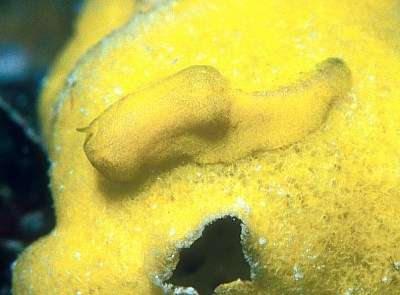
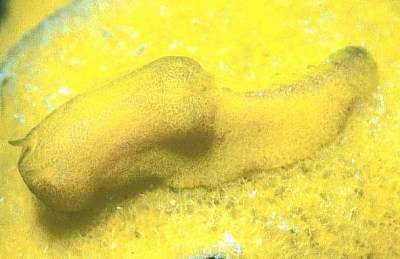
Hi Bill
Here is what appears to be a tiny (around 15mm) specimen of Notodoris citrina. The photo does not show it as it was found. It was on sandy rubble at the base of a vertical wall in fairly deep water on the seaward reef here at Kwajalein. The wall was encrusted with numerous colonies of this yellow calcareous sponge, and I moved it onto one of those colonies for the picture. I assumed that perhaps my bubbles had dislodged it, causing it to fall to the rubble below. So far, this is the first and only Notodoris we've found in the Marshalls, although I've seen the three other species - Notodoris minor, Notodoris gardineri, and N. serenae - at Pohnpei, about 500 miles to the west in the eastern Carolines.
Scott
johnson@kmr.ll.mit.edu
Johnson, S., 2000 (Feb 7) Notodoris citrina? from the Marshall Ids. [Message in] Sea Slug Forum. Australian Museum, Sydney. Available from http://www.seaslugforum.net/find/1869Thanks Scott,
I've included an enlarged view of your photo to show how the pattern on the skin matches the spicular skeleton of the sponge both in size and arrangement. Being on the sponge, your photo shows this even more clearly than my photo did.
Bill Rudman.
Notodoris citrina from Papua New Guinea
February 5, 2000
From: Mary Jane Adams
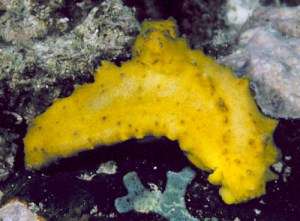
Hi Bill,
I couldn't find a photo of Notodoris citrina in your species list. I believe I have one from Papua New Guinea. [End Bommie, Horseshoe Reef, Bootless Inlet]. Another diver found it at 25-30 meters and brought it to me. I don't know what it was found on. Nov. 18, 1996. This is the only one I have seen.
Best regards,
Mary Jane
mjadams@earthlink.net
Adams, M.J., 2000 (Feb 5) Notodoris citrina from Papua New Guinea. [Message in] Sea Slug Forum. Australian Museum, Sydney. Available from http://www.seaslugforum.net/find/1807Thanks Mary Jane,
Notodoris citrina was one of the many species I still need to add. I rely on 'people power' at times to decide which ones to add. So now there is a N. citrina page.
Best wishes,
Bill Rudman.
Camouflage in Notodoris citrina
February 5, 2000
From: Bill Rudman
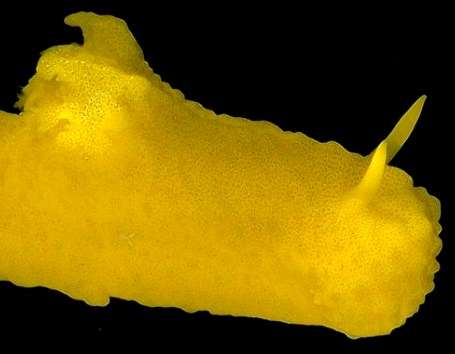
While preparing the Notodoris citrina page I came across this photo which shows its remarkable skin texture which is almost identical to the structure of the calcareous sponge Leucetta on which it feeds. To further camouflage the animal, species of Notodoris have flaps of skin which arch over the gills, hiding them from being seen from above.
In my experience, one behavioural difference between N. citrina and the other well-known yellow species (Notodoris gardineri, Notodoris minor) is that whereas those latter two are almost always nestled on their food sponge (Pericharax), N. citrina is often found on the substrate, crawling between the smaller colonies of its food sponge. In these instances, as I have suggested for the red Rostanga arbuta, looking like the food sponge means that you are well hidden when you are on the sponge, and have the potential to be mistaken for a sponge colony, when off it.
If you look carefully at the photo, halfway down the body and just anterior to the gills, you will see a yellow commensal copepod with its pair of egg sacs. Another example of camouflage.
The photo was taken by me in Nouméa, New Caledonia, 15 October 1988. 35mm long alive.
Bill Rudman.
